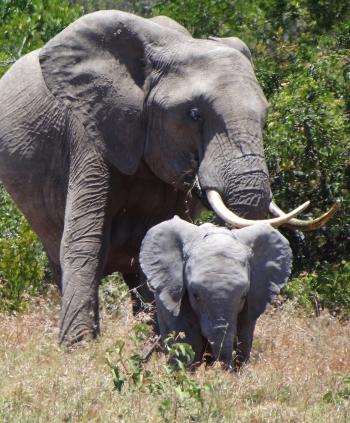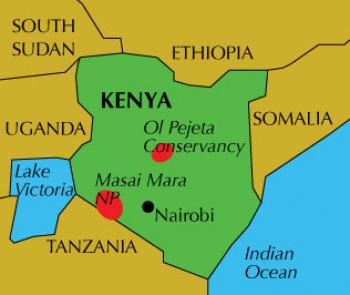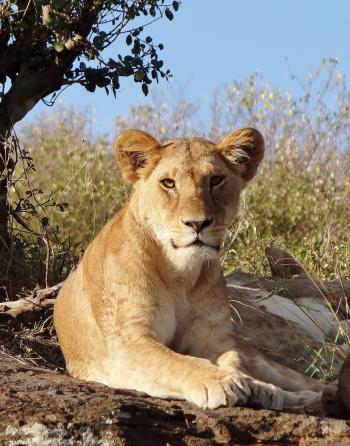An amazing Kenyan safari amid the pandemic
This article appears on page 6 of the July 2021 issue.
Even before leaving for a Southern Africa safari in September 2019, my two friends, Cynthia and Jim Lyon, and I had already booked a trip to East Africa for September 2020. All three of us love to travel, and nothing nourishes our souls more than a wildlife trip. Who knew that a global pandemic would ground us for most of 2020?
As spring wound into summer, our hopes of traveling to Kenya were quickly dimming, but we still fanned a little flame of optimism. In early July 2020, it was announced that Kenya would reopen to international travelers in August. Yeah!
But the process of “threading the needle” would not be easy.
Last-minute hurdles
Delta Air Lines changed our original flight routing, which had only one short connection in Amsterdam, four times, resulting in a final itinerary that included a connection in New York and a seemingly interminable layover (12 hours) in London before finally continuing on to Nairobi.
None of the concourse eateries or shops were open at New York’s JFK airport, and we were restricted from leaving the concourse in Heathrow, as Great Britain was shut down to foreign travelers. As business-class travelers, we ordinarily would have sought the comfort of the Delta Sky Club Lounge, but it, too, was closed.
We knew that the Kenyan authorities would not let us into the country without a negative Covid-19 test, but, thankfully, visitors were not required to quarantine.
Originally, the Ministry of Health required incoming passengers to have a negative test certificate issued within 96 hours of departure from the US, but just weeks before we were scheduled to leave, this changed to 96 hours before the time of arrival in Nairobi. Because of our travel time, this sliced 36 hours off the 96 we thought we’d have!
Our local news was reporting lengthy delays on receiving test results, so we were very anxious about being able to have the test and get results within the window required before setting off on our trip. We ended up getting tested at three different clinics, hoping and praying that one would deliver a quick turnaround. Thank goodness we did, because only one met the deadline the day before our departure. (The other two came dribbling in after we were already on our way.)
The plan
My friends and I often travel on group tours, but for wildlife safaris, we’ve found that booking a private tour through an in-country travel company provides reliable service and can save a great deal of money. After doing some research on Google, I found Gamewatchers Safaris (in the US, phone 877/710-3014, www.gamewatchers.com), based in Nairobi.
Gamewatchers is one of the longest-established safari outfitters in East Africa. Travelers must book their own international flights, but the company takes care of everything else, from arrival to departure.
Although we pretty much corresponded with their team in Nairobi via email, they also have safari advisors in the US, UK, Canada and Australia to whom you can speak.
We took advantage of a special offer: if we stayed in at least two of their safari camps for six nights, we would receive one additional night at another camp for free. Ultimately, we booked a 12-night itinerary that included stays at five different safari camps; a one-night stay in Nairobi; three bush flights; all transfers; all meals and beverages (including spirits, beer and wine), and all safari drives. My friends each paid a shared rate of $7,956, and I paid a single rate of $9,583.
From the moment we touched down in Nairobi, everything was handled perfectly by Gamewatchers. Two of their reps met us plane-side and assisted us through Immigration and our medical screening. Jim’s luggage somehow did not get on the plane, but the company handled everything to have it traced and ultimately delivered to us three days later.
The adventure begins
Gamewatchers Safaris operates six permanent tented camps (branded Porini Camps) located in community-owned private wildlife conservancies, most adjacent to national parks like Amboseli and the Masai Mara. We stayed in four of their camps, and while they are not top-end luxurious, their rustic charm provided all the comforts we could want. Each offered just 5 to 10 guest tents.
Unfortunately, the Covid-19 pandemic gutted the safari industry, so we found ourselves to be the only guests at each camp on all but one night. While this treated us to the ultimate private safari experience, we were saddened that the camps had been closed for six months, with guides, drivers and staff all furloughed.
During our game drives in each conservancy, we rarely ran into another safari vehicle and, therefore, had viewings of the wildlife to ourselves — much different than the cluster of 4WD jeeps surrounding animals, cameras clicking away, that often has been my experience in the past. One camp manager even told us that while they were closed, lions routinely wandered through camp!
Our first Porini camp was Nairobi Tented Camp, located only 20 minutes from the airport. It is the only accommodation set within Nairobi National Park.
No sooner had we left the airport than we saw a mother rhino with her baby. Ahh… all my anxiety about this trip just slid away! After a late breakfast and some much-needed rest, we set off that afternoon on our first safari drive in the park.
Nairobi NP is one of the only national parks in the world situated within a capital city (downtown Nairobi is less than 7 kilometers away). It was thrilling to be driving through thick bushland observing herds of zebras, buffalo and antelope with the skyline of the city clearly visible as a backdrop.
The next day we took a bush flight north over the Aberdare Mountains, landing on the dirt airstrip of Kenya’s Laikipia County. Small herds of zebras and impalas grazed nearby. (We were told they frequently have to be shooed off the runway before planes can land.)
Our stay for the next three nights was at Porini Rhino Camp, located within the 90,000-acre Ol Pejeta Conservancy. This conservancy has the largest population in East Africa of the endangered black rhino, and we were fortunate to see them on nearly every game drive.
We also visited the Northern White Rhino Conservation Center, home to the last two known animals of this rare species on the planet. From the safety of our 4x4 vehicle, we fed carrots to these two lone surviving females, Najin and Fatu.
The Masai Mara
Late each summer, over 2 million wildebeests, zebras and gazelles migrate from Tanzania’s Serengeti to Kenya’s Masai Mara in search of lush grazing grounds and life-sustaining water. Hoping to witness one of the iconic river crossings of these determined herds, we booked our next camp stay at Entim Camp (not a Porini camp but booked for us by Gamewatchers), a property located alongside the Mara River at a favored crossing point. Although we were not fortunate to see a crossing, the plains were full of the herds. (Seeing a crossing takes luck and patience, as it can take hours for that first wildebeest to pluck up the courage to leap into croc-infested waters.)
Our 2-night stay there was rewarded with plenty of big-cat sightings, including two male lions who are stars of the BBC TV series “Big Cat Diary” and a rare coalition of five male cheetahs whose strength in numbers has allowed them to specialize in taking down wildebeests.
We also took a hot-air-balloon ride, lifting off into a fiery, early-morning sunrise before enjoying a traditional champagne breakfast in the field where we landed.
Over the next five nights, we stayed at two more Porini properties, Mara Camp and Lion Camp, both located in private conservancies adjacent to the Masai Mara National Reserve.
While I loved the adrenaline-pumping action of the safari drives, the time spent in camp was also enjoyable. There’s nothing better than falling asleep to the sound of lions roaring in the distance, answered by a laughing hyena, or even the ear-splitting screech of tiny bush babies!
Since none of the camps were fenced in, it wasn’t unusual to have bushbuck cropping the grass right next to our tents or to return from a night drive to see two huge African buffalo grazing right out front. And did I mention the three elephants that sauntered right next to my tent one morning, making that low-pitched rumbling as I was brushing my teeth on the other side of the canvas?!
Mara Camp and Lion Camp delivered a wealth of animals, including big-tusked elephants with 3-month-old babies; hippos; hyenas; jackals, and a lioness with two 3-week-old cubs that peered at us with curious blue eyes. But we still had one elusive predator we had yet to see: a leopard.
Not but a week before leaving on our trip, I watched a new program on Nat Geo Wild called “Jade Eyed Leopard,” the story of Fig, a mother leopard, and her young cub, Furaha (referred to as “Toto,” Swahili for “cub,” in the show). This program was filmed right in the conservancy where Lion Camp is located.
On each game drive, our guides made a resolute effort to locate Fig or Furaha, driving along the rivers and gullies that they favored, but no luck. We had no complaints about the lions and cheetahs we did see, but we had so hoped to spot one of the two feline TV stars.
On our final day and last game drive, we went in search again. After looking behind every bush and thicket, our game spotter quietly exhaled, saying, “Finally!” There, up ahead, was Fig’s daughter, Furaha, born two years before.
We watched her leap up a tree into the large nest of a pair of Egyptian geese. She proceeded to snack on their clutch of eggs while the distraught parents dive-bombed the nest again and again. Then she jumped down from the tree, on the prowl for a more satisfying meal.
We followed her as she wound her way through a shallow ravine. All of a sudden she paused, changed direction and headed directly for our open 4x4 Land Cruiser. My jaw dropped as she slowly crouched and crawled under our vehicle. When she emerged on the other side, she nonchalantly continued on her quest.
It was worth the wait to see this majestic cat!
Final night
Flying back to Nairobi, we treated ourselves to an overnight at Giraffe Manor. This boutique hotel in the Langata suburb is situated in a period-decorated, 90-year-old colonial manor house. Guests are able to enjoy the resident herd of endangered Rothschild’s giraffes, feeding them special kibble during teatime and sharing breakfast with them as they stick their heads in the open windows to enjoy more kibble and offer up slobbery kisses.
My friends and I remarked so many times during our journey how fortunate we were to make the trip, and we were glad that we could do our small part to support their slumping economy. I always felt safe, with the airlines and camps taking every measure possible to ensure our health.
When we go on our next safari (not if), we will definitely book through Gamewatchers Safaris.



